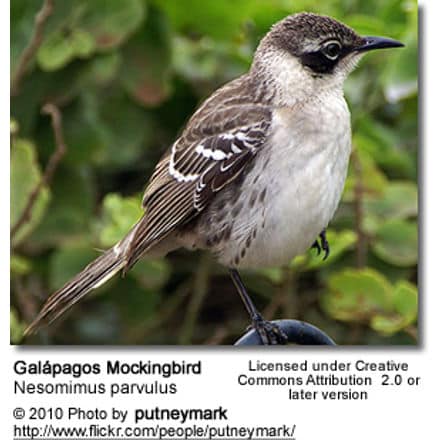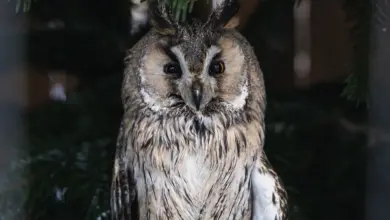Galpagos Mockingbirds
The Galápagos Mockingbirds (Nesomimus parvulus) is a species of bird in the Mimidae family. It is endemic to the Galápagos Islands, Ecuador.
Description
The Galapagos Mockingbirds is easily spotted on the Galápagos Islands due to its feathers which are streaked brown and gray, long tail, and smaller size, and black, angled beak.
The bird has a darker color than other mockingbirds on the islands causing it to blend in with the coral sand of the islands that it mainly inhabits. Its natural habitats are subtropical or tropical dry forests and subtropical or tropical dry shrubland.
Although they can fly, they are known to be seen running around more than flying which has let to comparisons to road-runners.
Diet / Feeding
Like other mockingbirds it is omnivorous, but it is more predatory than the related species in South America. It preys on small lava lizards, insects, centipedes, carrion, seabird eggs, and young finches. It will also devour any food left out by people visiting the islands.
Calls / Vocalizations
It has a very clear call that sometimes varies, but unlike other mockingbirds, Galápagos mockingbirds are not mimics.
Behavior
The Galapagos Mockingbird fights with other birds making it an aggressive bird, but is known as a bird that does get quite close to people, seeming fearless.
They are unique in that when the hatchlings are born, the juveniles help out with raising them.
Another unique living style is that while living in communities, the oldest male holds responsibility for providing food for and taking care of the young ones. The fact of whether he is the parent does not matter, and he is usually referred to as the alpha male of the group.
The birds build their nests in trees and cacti. About two or three females in each group breed at a time, but it can range from one to several breeding females in groups sized from 2 to 24. The males in the groups that aren’t breeding are “helpers” and help the breeding females, but the females that are not breeding, hardly ever help out. This helping shows the influence of kinship.
History
The Galapagos Mockingbird descended from the Ecuadorian Long-tailed Mockingbird.
There are three other species of mockingbirds found on the Galapagos Islands, but the Galapagos Mockingbird is the first one that was found in Darwin’s trip to the islands in 1835. They had a greater influence than any other animal on Darwin’s theory of evolution when he arrived there because it was the first species that Darwin noticed distinct differences among when he looked from island to island. This is what caused more species to develop.
The Galapagos Mockingbird is the one seen about the archipelago more than any other mockingbird. They are seen among the islands of Santa Cruz, Santiago, Isabela, Fernandina, Santa Fe and Genovesa, but is thought to have originated in San Cristobal. Although they seemed alike on both the islands of San Cristobal and Isabela, they seemed different on Floreana and Santiago.
Adaptation to the climate
Because of the climate that the Galapagos Mockingbirds live in, their social organization is quite different than others.
Their mating structure changes depending on which gender outnumbers the other. When there are more males than females, it is monogamous, and when there are more females than males, it is polygynous.
Joint nesting occurs quite frequently during the polygynous time.
Their breeding seasons go with the times of year. During El Nino, they breed a lot, and during the times of drought, they don’t breed at all. Although a lot of breeding takes place during El Nino, it also causes a lot of deaths in the mockingbirds because of all of water. This change in weather is the main reason why their population fluctuates so much.





